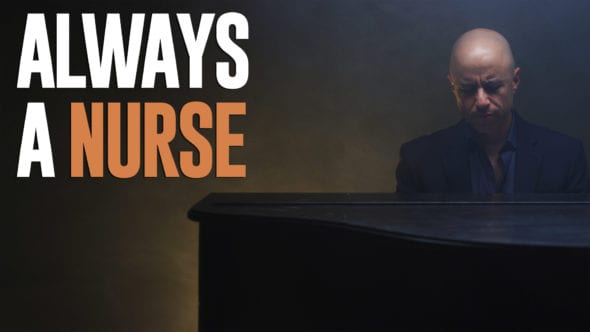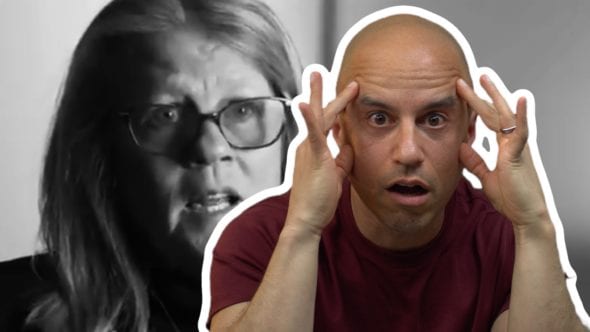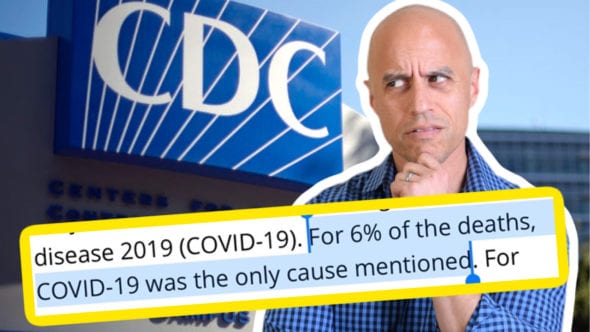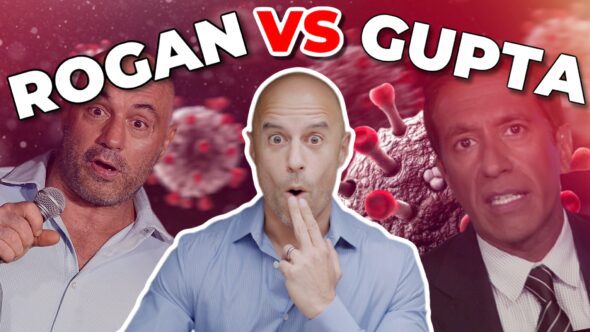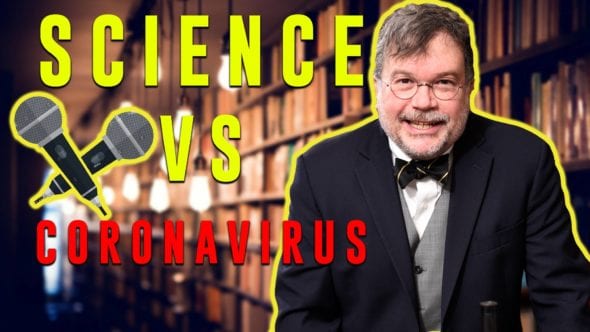Are we TRYING to create anti-vaccine sentiment? Excerpted from a live show I did for my Supporter Tribe.
Here’s a piece I did on understanding clotting risk from J&J and Astrazeneca vaccines.
Join our Supporter Tribe for these live discussions here.
Full Transcript Below
– Vaccines, let’s talk about ’em right now. There’s so much going on, and I think it’s freaking people out to the point where they don’t wanna take this vaccine anymore. And honestly, if I’m putting everything out there right now, the vaccines are our main hope to end the pandemic quickly and get back to whatever the new normal is. And I say new normal, because the old normal sucked. I don’t wanna go back to that. I don’t wanna go back to sitting in traffic and suffering through in-person meetings that are useless, when we can actually learn stuff from the pandemic. But taking our masks off, hugging our friends, going back to concerts, yes. Yes, and yes, and yes.
And how do we get there? We vaccinate enough of the population that the cases decline and we protect vulnerable people. And it may not be full herd immunity, but we get darn close. Remember that herd immunity, I like the term community immunity, is, it’s not a fixed number. What it says is there’s just not enough targets of opportunity for the virus to spread rampantly like a brush fire. It’s kind of like when you look at wildfires. Wildfires spread fast in California now because there’s been years of drought, things are dried out, and a bunch of fuel is built up. So any spark has an easy place to go and ignite a new brush fire. That’s how early pandemic was when no one had real immunity to this thing, right, you know?
So, what the vaccines do and natural infection, like Jay Bhattacharya who was on the show the other day, he said, “You know, people who deny “that natural infection induces immunity “are immunity deniers.” It does, right? And whether it’s the degree that the vaccines do or not, it’s almost irrelevant, because as long as you have some immunity, right, you’re gonna reduce the targets of opportunity for the virus. So, where does herd immunity come in? It comes in when they’re just simply aren’t enough targets, there aren’t enough dead, you know, sort of fuel in the underbrush that’s been building up that’s easy. Instead, the fuel is wet. It’s been soaked by rain.
And the rain is the form of existing immunity, whether it’s because you’ve been infected before, so you’ve had a recent controlled burn and there’s nothing there to burn, or you have been soaked with rain, which is the analogy I can make for the vaccine. The vaccine makes your fuel less suitable for the fire of the virus to ignite. And so, herd immunity is a kind of an equilibrium that we come to when enough of the fuel has been wet or has been burned away already that there’s just not much place for the virus to go, so it stops replicating, and it sort of peters out. Now, I don’t know that we’ll ever get to a full herd immunity in the sense that the virus never can replicate.
Like say measles, like, you can get to a really solid herd immunity with measles, ’cause it’s just the nature of how that vaccine works, it’s very effective, like 97% effective, and how the virus spreads, and so on. But with, and the, you know, extent of the vaccination that we have, it’s what they call sterilizing immunity. You know, once you’re immune, you’re good, right, pretty much for life for the most part. I think we’ll have this thing where the virus can still infect people, but they have enough existing immunity that they never get that sick. So it becomes more like a common cold. It becomes endemic, meaning it’s always circulating every winter or whatever, it’s kind of seasonal, but it never actually fills our hospitals with people proned on ventilators who are dying, which is what you want. And I suspect that a lot of early, you know, a lot of our historical coronaviruses that now cause the common cold, or parts of the common, they’re contributors to common cold, started out like that.
And Jay Bhattacharya and I talked about that theory in Russia that this may have happened even as recently as, you know, a little over 100 years ago. And then, they become part of our normal circulating viruses. We don’t have these aggressively crazy sicknesses from them. And that’s probably where we’re gonna get. So, where do vaccines come? By vaccinating, we prevent like, oh, you can accomplish, you could accomplish ending forest fires by burning all the forest down, and they’re just a few trees that, you know, that survive that, you know? Actually, if you’re making an analogy to coronavirus, 99.7% of the trees survive, but some of them are actually damaged, some of them have longer-term symptoms. But then, you still lose a lot of really precious trees, even if it’s just 0.3%, which is felt to be 0.2, 0.3, the infection fatality rate of COVID.
Those, you know, giant sequoias or whatever that die, they’re not coming back. So, you could reach herd immunity by just letting a virus rip through the community, but that is a terrible cost to pay for that. So what the vaccines do is, first of all, they protect those vulnerable trees and they protect other less vulnerable trees that are not gonna die, but they keep ’em from even possibly being infected and spreading it to vulnerable people, or trees if we’re keeping with the analogy. So, that’s why getting the vaccine in as many arms as possible is crucial. So, how then have we managed to screw this up and make people even more afraid when none of that was actually necessary?
So, it really wasn’t necessary to create this much fear. Well, let’s go through a few things, okay? First, the Johnson & Johnson/AstraZeneca thing. Now I’ve done a show on this. What’s going on? There are these rare, and I use rare with a capital, all caps, RARE blood clots, mostly in women. They’re unusual and they’re accompanied by low platelets. So it’s a kind of a syndrome they’re calling VITT, Vaccine Induced Thrombotic Thrombocytopenia. And this syndrome has been discovered because you have millions of people being vaccinated. It’s not a long-term syndrome. It happens days out from the vaccine.
It’s not like, you know, people are all concerned, “Oh my God, what are the long-term consequences of this?” Well, a single injection once doesn’t have many long-term consequences of any kind except for immunity, a memory immune system, right, which is what you want. But this is a sort of relatively immediate consequence. And the rate of it is something along the lines of just shy of being struck by lightning or less, depending on whether you’re talking about J & J, AstraZeneca, and how old you are. So, what they did when they found these results, which by the way, is an amazing testament to actually the fact that science works. But think about this very carefully. If the big pharma companies were really this cabal of conspiracy-minded, you know, controllers of the public that we, that many feel like they are in the conspiracy community, how the hell did this get out, this extremely rare blood clotting thing? They could have easily kept it under wraps, right? But no, because the doctors are seeing it, they’re reporting it, and science works, period. Post-marketing surveillance worked. So, this thing is actually, and I’ve talked about what the theories are about why these particular adenovirus vector vaccines, Johnson & Johnson and AstraZeneca, might be causing clotting, so we won’t rehash all that. But the idea is it’s very rare. So, what should’ve happened is the authority should’ve said, “Oh, okay, this thing’s happening.
“Let’s quickly go figure out who it’s happening to.” And remember, we’re talking about CDC, we’re talking about FDA, we’re talking about federal government. Like, they can do this data acquisition. It’s not rocket science, it’s just epidemiology. Call up the doctors that are seeing the cases, get every single detail of every single case. How old were they? Were they on oral contraceptives? What’s their gender? What other medical problems did they have? Did they previously have COVID? Was this like a booster effect? Get all the data you can, and that day, you can put out an APB to the public and say, “Okay, this is the rate that we’re seeing. “This is the risk factors.”
So now you can make an educated decision as to whether you in that particular age group wanna get that vaccine or not. By pausing, by saying, “We’re just gonna put a clamp on this “till we can figure out what’s going on,” no, you can figure out what’s going on pretty quick, and then tell the public. Just say, “This is what’s going on. “You can make a decision now based on this data “that we have. “You can talk to your doctor.” And then, FDA or CDC or whoever’s doing this can go to doctors and say, “This is what’s up, “so this is what you can talk to your patients about.” By pausing it, what they’ve done is irreparably harmed the reputation of that vaccine to the point where people are now so scared, they’re never, I mean, there’s so many people that are just gonna be like, “I’m never gonna take that,” they put it on pause. This true of AstraZeneca. It’s true of Johnson & Johnson. It’s true in Europe. It’s true in the United States.
Sometimes, I just don’t know. And then, people say, “Well, if you didn’t pause it, “it would’ve looked really bad.” No, you go to the public and you tell them the damn truth! You say, “Here’s what’s going on. “Here’s the data we have. “We’re continuing to work on it, “but we’re gonna continue to make this vaccine available. “But you’ll be informed “so you can make an educated decision, “because we’re not gonna treat you like a dumb ass. “We’re gonna treat you like a grown adult. “We’re not gonna keep, you know, “oh, just stop, stop, stop, pause it.” Terrible idea, ’cause now it’s generating all kinds of crazy anti-vaccine hoo-ha. Is that a thing? And we, we’re never gonna, it’s gonna be so hard to undo. Now, and it gets worse. It gets worse! So, on top of that, and by the way, this is not to minimize, this is not to minimize the fact that these unusual blood clots can cause death and disability in otherwise young and healthy people, right?
The women that are affected, mostly women that are affected by this, it’s a tragedy, right? So, but many of our medical interventions have huge, by comparison, risks. Like taking an aspirin, you can bleed from an ulcer. Taking ibuprofen, you can bleed from an ulcer. I mean, there’s so many things we do that we just take for granted that have a much higher risk than this, right? But that doesn’t mean that it lessens the tragedy of people who’ve suffered from this, right? And the stories are very powerful. Humans are story-driven creatures. What we don’t tell stories about is well, okay, then there were the everybody else who got Johnson & Johnson who had one shot and are now 85% protected from severe disease that would hospitalize them that would’ve taken how many lives, instead they’re not getting that vaccine. We don’t, those are stories that we don’t tell. Do you see what I mean? It’s easy to empathize with a 48-year-old woman who had no other medical problems who’s now dead. That’s a horrible story, and it is. But you don’t empathize with the abstraction of the lives lost, because we’ve screwed up the messaging on how to do this, ’cause now people aren’t gonna get vaccinated.
So, that’s how you really, I mean, if you’re looking from an alt-middle integral rationalist perspective, that’s how you have to look at these risks, right? And I’ve done videos that go in depth on the risk of this thing, and so on, so you can look at those. So, that being said, what else did, I said it gets worse, what else did Johnson & Johnson do to even make this worse? So Johnson & Johnson themselves at one point put out a press release saying, “Hey, these blood clots are happening…huh “They happen with all the vaccines, even the mRNA vaccines.” Well, it turns out that’s just not true . They said something that was abjectly false, and they cited a paper, whose then author came out and said, “No, that’s not what we said in the paper at all. “We have not seen this evidence of clotting “above the background rate in the mRNA vaccines, period.” What the hell are you doing, Johnson & Johnson? They should be ashamed of themselves, because what does that do? It’s almost like, “Well, oh hey, “if we’re gonna be targeted , “guilt by association, the mRNA vaccines.” Shut the hell up! Are you kidding? That’s gonna promote more vaccine, understandable vaccine hesitancy, right? Humans are story-driven creatures.
They just heard a story from Johnson & Johnson. By the way, they had to back that up. So then, they’ve never said that again, and they got crapped on by everyone appropriately. I don’t know what’s going on with that company. Now, let’s take a crap on pharma a little more for a second when it comes to vaccines, because I often get accused of being pharma’s booster. No, no, no, no, no, no, no. I am the booster of anything scientifically shown to help human beings and relieve suffering, right? Now here’s what pharma got really wrong, the J & J piece. Now, the second thing they did is you got the CEO of Pfizer coming out and saying, “Oh, by the way, “there’ll probably be a required booster in the fall. “And then, probably annual requirement “for the vaccine, you know? “You’ll need one.” Remember Pfizer makes one of the mRNA vaccines. Okay, stop for a second. First of all, Mr. Pfizer, you don’t make requirements for vaccines. You don’t make that. If they’re required, it’s a government or a institutional requirement. You don’t get to say it’s required, right, number one. Number two, based on what? Because me as Joe Q. Public hears that and goes, “Here’s a guy who wants to make a butt-ton of money.”
I already manned up and got the mRNA vaccine times two. I felt like crap. I’m just saying, we’re the Joe Q. Public. I felt like crap. I had fevers, I had muscle aches, but now I’m supposedly immune, right? Why the hell am I being told I need to get a booster? First of all, and I’m afraid of needles, and I overcame that to do my piece, not just for my own health, but for the health of my community and generating community immunity. And now, you’re telling me a required booster in the fall? No! Worst and stupidest messaging I’ve ever heard in my life. Right? And by the way, the reason he’s saying that is he’s probably projecting that while if variants are somewhat resistant to the current vaccine, which they’re somewhat resistant to it, but they still, the current vaccine still prevents severe disease, so who cares? Then we can make a booster where they’re not resistant to it ’cause we just have to tweak the mRNA coding, and now you have a booster vaccine that’ll cover the variants. Well, why don’t you say we can offer that for people who want higher levels of protection, the vulnerable, et cetera, but you don’t need to have it. I mean, at that point, hopefully we’ll have some community immunity and we just won’t need to have it. I mean, that’s how you, “We’re working on this. “I mean, it’s something that we might offer.” Give me a break! And then annual, how do we know that? How do we know that, Joe Q. Pfizer? We don’t know that. It might be that the thing becomes endemic.
Why the hell would you want a vaccine against the the common cold every year? You just get the common cold, who cares? It’s different than flu that can potentially kill you or kill a young or old person. Talking about, you know, what’s gonna eventually be endemic. To me, this is just horrible, stupid, idiotic messaging. And they should be, I mean, they should be regulated for saying stuff like that, right? And of course, he was speculating on CNBC or whatever, but that’s even more problematic because it gets picked up by the idiot mainstream media that puts it everywhere. And now, they’ve poisoned the minds of everybody with something that’s not true. It’s simply just, the way that it’s framed is incorrect.
So, let’s stop talking about this right now. They can work on it. Now, I think Moderna did something interesting. They actually said, “You know, what we’re working on “is we’re working on a booster shot, you know, variants,” because people love to say variants. “But we’re working on combining it with an influenza vaccine “so that you can just get one shot, “get your flu shot and your COVID update in the same shot.” Now, that sounds pretty f-ing good to me, because if you’re gonna get the flu shot anyways, which hey, yeah, then might as well combine it with updated COVID, even if it prevents you from getting a cold-like syndrome for a week, that’s worth it, right? So, this is kind of how we wanna go. Now, Colleen Cornell says, “They don’t want it to end.” You’re right, they don’t! I don’t think pharma wants it to end. I don’t think the media wants it to end. Why? Because they’re minting money. To be honest, you wanna go in one step further? Rich people don’t want it to end. Do you think, like someone like me, right? I make a living doing this. And then, you know, I’m also academic faculty at UNLV and I round there and see patients, but that’s a figurehead position and it’s a teaching position, and I don’t make money on patient care anymore, which has freed me to say what I want. But I do this. If suddenly the pandemic ends, eh, are that many people gonna be interested in what I have to say about medicine? Probably not. This is the first time in their lives they’re interested in health, eh? So I lose a ton of money.
I’m actually rooting for that to happen. I want that to happen. That’s what I want, ’cause I have my supporters who we’ll still talk and we’ll do this, and we’ll move on and talk about other things that are important to our tribe. But the truth is there are a lot of people who benefit from telling other people to stay home. And when that ends… Which, you know, and it’s another question, so more messaging problems with vaccines. Oh, you can get vaccinated, but you still have to wear a mask. You still can’t do your usual stuff. Shut up! You can , especially with other vaccinated people. You absolutely can! Oh, but there’s still people breaking through and having infections. Yeah, the vaccine is 90% effective at six months so far. That means 10% of people could still get infected. What’s the percentage of severe disease and death? Very, very small once you’ve been vaccinated. So, what do you want, a miracle? Do you want a miracle? ‘Cause that’s not gonna happen. This whole pandemic has been a crap show. You suddenly expect a miracle? No, you expect real world improvement, and that’s what the vaccines do, so let’s get back to life. What’s gonna happen is we’re rapidly going to see, this is what I’m gonna say, we’re gonna see cases decline as vaccines go up, we’re gonna see deaths and hospitalizations rapidly decline, and we’re gonna get back to a new normal ASAP, And I actually think we’re gonna be able to rip our damn masks off and be done with that much sooner than we think.
And that’s what we need to be messaging, because that’s gonna encourage people to do the right thing for them and their community, which is get a vaccine. The worst thing is to die at the end of the pandemic of COVID when you’re this close, right? So, that’s really what I think, you know? And, you know, you know, like Lisa Goodman says, “Texas feels more and more like pre-COVID days. “Most folks I know are vaccinated here.” The vaccines are the way out, period. We were talking about Michigan with Jay Bhattacharya on the show. Michigan is an interesting case, because they did so many aggressive lockdowns early on, they probably just delayed people getting infected.
Everybody else got infected earlier. And then, they’re vaccinating, they have high vaccination, but it’s not perfect penetrance of the vaccine, so they’re still getting cases, a lot of cases. Vaccines are the way out of this. Let’s get on with life. That’s really it. Now, here’s another thing I gotta say. Most of the deaths, most of the deaths during this pandemic were preventable, and I’m not talking about preventable in the way New Zealand prevented it by basically shutting down their borders, having the good grace to be in the Southern Hemisphere in a summer during the beginning of the pandemic, so lower seasonality effect for them, and having closable borders, you know, racking up their economy and destroying their tourism, and you know, all of that, they’re willing to do all that to have COVID zero. I’m not talking about COVID zero.
That was not possible in the United States when the thing had already gotten out. I’m talking about something like 40% of deaths were nursing home population. Jay Bhattacharya was saying on the show something like 80% of the deaths were in the elderly population. So, targeted interventions to keep them safe would’ve helped. But more important, the epidemic of shitty diet, chronic disease, obesity, hypertension, congestive heart failure, diabetes, all that stuff in the United States, that’s all, mostly, I’m not talking about like, Type 1 Diabetes and that kind of thing, that is preventable. We eat like crap. Our big food industry subsidizes a sugar-rich processed diet. And we reap what we’ve sowed in the form of a population that, getting back to that wildfire analogy, was perfectly primed to go up in a massive eruption of death, which is what we saw, almost 600,000 deaths in the United States. How many of them were elderly, had two or more chronic diseases?
A whopping number of them, and this was preventable. And you know what? We hold up, okay, here’s an important thing. We hold up our doctors and our nurses and everybody as healthcare heroes, which they are, but we don’t hold them accountable for failing to prevent, for failing to address, for failing to change the system that pays them not to prevent disease, that looks down on primary care as something that’s just not, oh, you’re just not smart so you’re in primary care. It’s all specially-driven, intervention-driven stuff, like, well, we can patch you up when you have your heart attack, we can intervene with a stent, but hell no, we’re not gonna prevent your disease, ’cause that’s gonna cost us money. Who are we holding accountable for that? Who’s apologized for that? No one, you know? So, I don’t know, man, that’s my rant.
Category
- The ZDoggMD Show (818)
- Featured Videos (189)
- Doc Vader (142)
- Against Medical Advice (128)
- Medical Humor (95)
- Public Service Announcements (87)
- Music Parodies (74)
- Nurses (59)
- Meditation (46)
- The VPZD Show (38)
- ZVlogg (36)
- ZTalks (28)
- ZBlogg (24)

